Click on each thumbnail to view image in larger format
Chinese Hard Paste Porcelain
Blue and white underglaze -





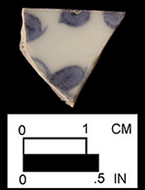

Kraak porcelain (17th century) body sherd of large
hollow vessel, probably a
klapmutsen (cross between
a deep dish and a shallow rimmed bowl as seen in
example below). http://www.onlinegalleries.com/art-and-antiques/detail/ming-blue-and-white-
porcelain-kraak-
bowl-by-wanli-ming/133886 (above).
body sherd of hollow vessel, probable bowl
(left) and close up of paste (right). Lot 246.

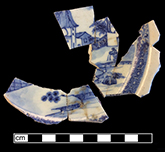

Chinese porcelain cup painted underglaze blue. 3.5” rim diameter.
Chinese porcelain saucer painted
underglaze
blue in pavilion landscape
pattern. Hex cell
diaper rim on cavetto.
Believed to be either Second (c. 1750-1780)
or Third Period (c. 1780-1820) Pavilion
Landscape pattern as discussed in
Madsen
and White (2011:81-85).
Chinese porcelain saucer painted underglaze
blue in a landscape pattern. Note the high
quality painting , particularly the shading of
the
mountain in the center of the sherd. The
largest of the two sherds has been damaged
through burning.



Chinese porcelain saucer painted under the
glaze in blue with trellis motif along rim.
Trellis motif dates c. 1690-1797 (Madsen
and White 2011:73). Brown dressed rim.
4.5” rim diameter.
Chinese porcelain shallow bowl painted
under the glaze in blue with trellis motif along
rim and floral motif. Trellis motif dates
c. 1690-1797 (Madsen and White 2011:73).
6” rim diameter; 1.5” vessel height.
Chinese porcelain saucer painted under the
glaze in blue with fish roe; (small circles with
dot in center) motif along rim.
Fish roe motif
dates c. 1740-1770
(Madsen and White 2011:94).


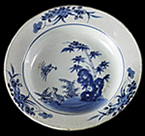
http://www.lukehoney.co.uk/products/a-set-of-four-chinese-blue-white-plates-18th-century#.V4jdpPkrLcs

Chinese export porcelain saucer in pavilion
landscape motif. Probably first period
(c. 1710-1750) as discussed in Madsen
and White (2011:79).
Chinese porcelain saucer painted underglaze
blue with bird central motif. Spearhead motif
(c. 1722-1797) encircling cavetto. 18th-century soup plate decorated with similar
motif, from private collection on right.
Chinese export porcelain teapot stand painted
under the glaze in blue with spearhead motif
(c. 1722-1797). Reverse is unglazed.



Chinese porcelain cup painted under the glaze
in blue with spearhead motif (c. 1722-1797).
3” rim diameter.
A variety of Chinese porcelain vessels
(saucers and plates) painted under the glaze in blue with trellis motif along rim. Trellis motif
dates
c. 1690-1797 (Madsen and
White 2011:73).
Chinese porcelain bowl painted underglaze in
blue with trellis motif along exterior rim. Trellis motif common c. 1690-1797 (Madsen and
White 2011). Brown dressed rim.
6” rim diameter.


Chinese porcelain saucer painted
under the glaze in blue.
Approximately 5.5” rim diameter.
Chinese porcelain common shape cup
painted under the glaze in blue.





Chinese export porcelain saucer painted
underglaze blue in pavilion landscape motif.
Probably first period (c. 1710-1750) as
discussed in Madsen and White (2011:79).
Minimum Vessel 37 (Lot 2240).
Common shape cup painted underglaze in
blue with “chang” (entrails, endless knot)
symbol from Kangxi period (1662-1722) as
described in Mudge (1986:233). Madsen and
White (2011) date use of Kangxi symbols
as
late as circa 1750.
Minimum Vessel 33 (Lot 2344).
Common shape cup painted underglaze in
blue with “luo” (conch shell) symbol from
Kangxi period (1662-1722) as described in
Mudge (1986:233). Minimum Vessel 42;
Level 37 in well.
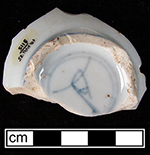


Common shape cup painted underglaze in
blue. Unidentified mark on base of cup,
possible artemesia leaf.
Minimum Vessel 6651 (Lot 3115).
Note: Cellar filled in mid-19th century with soil removed from yard of 18th-century house during landscaping.
Common shape cup painted underglaze in blue. Minimum Vessel 6651 (Lot 1848).
Chinese porcelain common shape cup
painted underglaze in blue with fish motif.
Brown dressed rim; 3.5” rim diameter.
Lots 2335 and 2336.


Chinese porcelain saucers painted underglaze in blue with trellis pattern in cavetto – dates c. 1690-1797
(Madsen and White 2011:73)
and with blue and white floral reserves (c. 1700-1751).
Minimum Vessel 57
(same number assigned to two distinct vessels by project archaeologists). Lots 2301, 2320, 2210.



Chinese porcelain octagonal deep plate
painted
underglaze in blue in Mandarin
pattern. This pattern imported in large
quantities to the west beginning mid-18th
century. Border design of
butterfly, scroll
and diaper with scales pattern
commonly dates c. 1785-1800 (Madsen
and White 2011:98). 6” vessel diameter.
Chinese Canton porcelain painted underglaze blue syllabub cup with twisted handle. This
vessel
would have originally had a lid. Probably dates to early to mid 19th century, based
on twisted
handle. 2.5” rim diameter, 2.25” vessel height.
Similar cup on right with lid from a private collection
Also see Canton Porcelain from our Post-Colonial section of the Diagnostic Website,
included in the Less Commonly Found wares section.
H & S Bakery 18BC32 |
Federal Site 18BC33 |
  |

|
| Chinese porcelain bowl painted underglaze in blue. 6.5” rim diameter. Photo on right shows vessel interior that is only glazed about 1” below rim. |
Saucer painted under the glaze in blue. The
trellis motif along |



Chinese export porcelain painted
underglaze plate. Rim diameter: 9.00”
Chinese export porcelain plate with
floral motif. Rim diameter: 10.00”
Chinese export porcelain painted
underglaze soup plate. Rim
diameter: 9.00”. Lot: unknown,
Provenience: 1G7.886.44



Chinese export porcelain painted
underglaze plate. Rim diameter: 9.00”.
Lot: 9, Provenience: 1G3.88.35
Privy Stratum 2
Chinese export porcelain painted underglaze
relish dish. 7.75” x 5.00”; Lot: 9, Proveneince:
1G3.474.2, Privy Stratum 2
underglaze dish. Lot: 9, Provenience:
1G3.884.18, Privy Stratum 2.

Chinese porcelain plate painted underglaze blue in Fitzhugh pattern. Rim has shaded trellis with spearheads and
double dots (alternately called daggers and dots). 7.75” rim diameter, 1.25” vessel height.
Fitzhugh pattern dates between c. 1765 and 1820 and the border pattern between c. 1765 and 1820 (Madsen and White 2011).
Combination over and underglaze -
18BC33 Federal Site/Block 1370
Feature 14 Privy (filled c. 1830s with garbage from an earlier household)

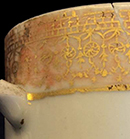



Chinese hard paste porcelain mug overglaze
painted in brownish red and gold gilt. Rim
diameter: 2.5”; Base diameter: 2.5”;
Vessel height: 2.5”
Chinese hard paste porcelain common shape
cup overglaze painted in brownish red and
gold gilt. Vessel height: 2.75” ;
Rim diameter: 3.5”
Chinese hard paste porcelain plate overglaze
painted in brownish red and gold gilt. This
feature contained a large number of vessels
in this patter and also contained an armorial
seal with the initials of -----.
Rim diameter: 8.0”
Clagett’s Brewery 18BC38
Peters� Privy, late 18th to early 19th centuries



Chinese export porcelain saucer, painted
overglaze. Rim diameter: 5.50”
Lot: 10, Provenience: 1G4.497.37,
Privy Stratum 3
Chinese export porcelain teapot lid,
painted overglaze in gold. Lots: 9 and 13,
Provenience: 1G3.884.1 and 1H.533.5,
Privy Strata 2 and 4.
Chinese export porcelain cup with
neoclassical motif. Rim diameter: 3.50”;
Base diameter: 1.75”; Vessel height: 2.00”.
Lot: 9, Provenience: 1G3.886.25,
Privy Stratum 2
Oxon Hill Manor/Addison Plantation 18PR175
Area VC � Feature 329 Burned passageway (1689-1730)



Chinese porcelain cup or bowl painted underglaze in blue and overglaze in enamels in black and other indeterminate colors.
Symbols on base possibly denote Yongzheng period (1723-1735) as shown in Mudge (1986:231).

Chinese porcelain saucer with floral motif painted underglaze in blue and painted overglaze in red enamel and gold gilt in Imari style.
Brown dressed rim. Madsen and White (2011) place the dating of the Imari style as c. 1700-1760. 5.5” rim diameter.
Oxon Hill Manor/Addison Plantation 18PR175
Area I Well, filled c. 1720-1750






Chinese porcelain bowl with floral motif painted underglaze in blue and painted overglaze in red enamel and gold gilt in Imari style. Top is vessel exterior, bottom photo is vessel interior. Madsen and White (2011) place the dating of seasonal floral motifs as c. 1700 to 1775 and of the Imari style as c. 1700-1760. Minimum Vessel 58
(Lots 2213, 2317, 2332).
Chinese porcelain bowl with floral motif painted underglaze in blue and painted overglaze in red enamel and gold gilt in Imari style. Brown rim. Top is vessel exterior, bottom photo is vessel interior. Madsen and White (2011) place the dating of seasonal floral motifs as c. 1700 to 1775 and of the Imari style as c. 1700-1760. Vessel rim diameter approximately 5 to 6”.
Chinese porcelain common shape cup painted in butterfly motif underglaze in blue and overglaze in red enamel and gold gilt in Imari style. Brown dressed rim. Madsen and White (2011) place the dating of the Imari style as c. 1700-1760. 3” rim diameter, 1.75” vessel height, Minimum
Vessel 61 (Lots 2337, 2338).



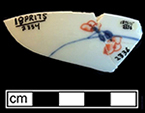


Chinese porcelain common shape bowl painted in floral motif underglaze in blue and overglaze in red enamel and gold gilt in Imari style. Brown dressed rim. Trellis band on vessel interior rim. Madsen and White (2011) place the dating of the Imari style as c. 1700-1760. 6” rim diameter. Minimum Vessel 169 (Lot 2331).
Chinese porcelain saucer painted in butterfly
motif underglaze in blue and overglaze in red enamel and gold gilt in Imari style. Madsen and White (2011) place the dating of the Imari style as c. 1700-1760. Top photo is vessel interior
and bottom photo is vessel exterior. 5.5” rim diameter. Minimum Vessel 170
(Lots 2334, 2336).
Chinese porcelain common shape cup painted in butterfly motif underglaze in blue and overglaze in red enamel and gold gilt in Imari style. Brown dressed rim. Madsen and White (2011) place the dating of the Imari style as c. 1700-1760.
3” rim diameter. Minimum Vessel 169
(Lots 2329, 2336).


Chinese porcelain saucer painted overglaze
with enamels in red, green and other
vestigial colors.
Chinese porcelain hollow vessel (bowl?)
painted overglaze with enamels in red and
green floral motif.
Federal Reserve 18BC27
Feature 26 – Privy first quarter 19th century


Similar 18th-century example on right from private collection. https://www.pinterest.com/pin/573646071263241361/
Chinese export porcelain tea caddy. Fugitive remnants of a polychrome painted overglaze floral design in the famille rose enamels
are visible on the front of the vessel. The arched shoulders and overhanging rim of this rectangular tea caddy are characteristic
of the second half of the eighteenth century (Pinto De Matos et al. 1996). 4” vessel height.




 .
.Chinese export porcelain cup painted over the
glaze in red in neoclassical rim motifs on
exterior and interior. Scalloped rim.
Neoclassical rim
bands were most common
on Chinese export porcelain between c. 1765 and 1810. Rim diameter 3.0”.
Chinese porcelain saucer or small plate
painted overglaze in famille rose palette and floral motif. Madsen and White (2011:106-107) place the dating of famille rose as c. 1720-1800. Floral spray motifs in famille rose
were popular from the 1740s through
the 1760s. 6.25” rim diameter.
Chinese export porcelain common shape
cup painted over the glaze with red enamel
on interior and exterior rims and floral motif
in famille rose palette. Neoclassical rim bands were most common on Chinese export
porcelain between c. 1765 and 1810
(Madsen and White 2011).
Rim diameter 3.5”, Vessel height 1.75”.
Note on the cup interior how the red overglaze enamel has turned black in one small area, due most likely to post-depositional factors.




Detail of husk chain motif

Chinese porcelain handled cup overglaze
painted in fashion called en grissaille Madsen
and White (2011:114) date this black-only
painted style to c. 1728-1805 for the
American market. Also called encre de chine.
2.5” rim diameter., 2.25” vessel height.
Chinese export porcelain handled saucer
painted over the glaze in black enamel in
neoclassical pattern. Cavetto painted with
husk chain motif. Neoclassical rim bands most
common on Chinese export porcelain
between c. 1765 and 1810. En grissaille
or encre de chine (black-only) painting
dates c. 1728-1805. Madsen
and
White (2011) date the husk chain to
c. 1765-1810. Vessel diameter: 5.5”.
Chinese porcelain common shape cup painted overglaze in red and black enamels and possibly gold gilt. Wavy band in red enamel on cup exterior rim dated c. 1780-1790 by Madsen and White (2011:116). 3.5” rim diameter., 1.75” vessel height.






Chinese export porcelain common shape
cup painted over the glaze with red and black
enamel on interior and exterior rims and floral
motif on vessel exterior. Neoclassical rim
bands were most common on Chinese export
porcelain between c. 1765 and 1810 (Madsen
and White 2011).Rim diameter 3.5”,
Vessel height 1.75”.
Chinese export porcelain saucer painted over
the glaze with red and black enamel on rim
and
floral motif in vessel center. Neoclassical
rim
bands were most common on Chinese
export
porcelain between c. 1765 and 1810
(Madsen
and White 2011). Rim diameter 5.5”. These sherds are from two different vessels.
Chinese export porcelain cup painted over the
glaze in red and black in neoclassical rim
motifs
on exterior and interior. Scalloped rim
and
fluted bowl. Neoclassical rim bands
were most
common on Chinese export
porcelain between
c. 1765 and 1810
(Madsen and White 2011).
Rim diameter 3.5”.


Chinese porcelain saucer painted overglaze
with enamels in red, black and other vestigial
colors. Overglaze decoration will often be
damaged or missing.
Chinese porcelain knob for tea caddy or
some similar vessel, painted overglaze in
red (rouge-de-fer, c. 1710-1739).
1.2” knob diameter.
Oxon Hill Manor/Addison Plantation 18PR175
Area I Well, filled c. 1720-1750



Chinese porcelain flat vessel painted
overglaze
in red enamel (probably
rouge-de-fer, common
c. 1710-1739) in
spearhead motif (Madsen
and White 2011:113).
Chinese porcelain saucer painted overglaze
in black with minimal rim banded decoration
typical of period c. 1765-1810 (Madsen and
White 2011:116). Minimum Vessel 6578
(Lot 3095).
Chinese porcelain plate painted underglaze
in blue and overglaze in red and gold with
dogtooth pattern rim banded decoration
typical of period c. 1765-1797
(Madsen and White 2011:117).
Minimum Vessel 6578 (Lot 2104).
Note: Cellar filled in mid-19th century with soil removed from yard of 18th-century house during landscaping.

|


|
| Chinese porcelain Canton style jar. | Rose medallion overglaze molded cup or small bowl decorated |



Chinese rice grain porcelain spoon. Painted underglaze in blue and overglaze in red. Body of spoon was pierced with the rice grain
(Linglung) pattern, which then filled with the glaze when fired. Cross section of paste shows the greenish glaze filling the piercings.
Although first used much earlier, this type of decoration was revived in the mid-19th century (Nilsson 2016a) and pieces found
archaeologically in North America almost certainly date to this period or later.
Back to: Top | Ware Essay



